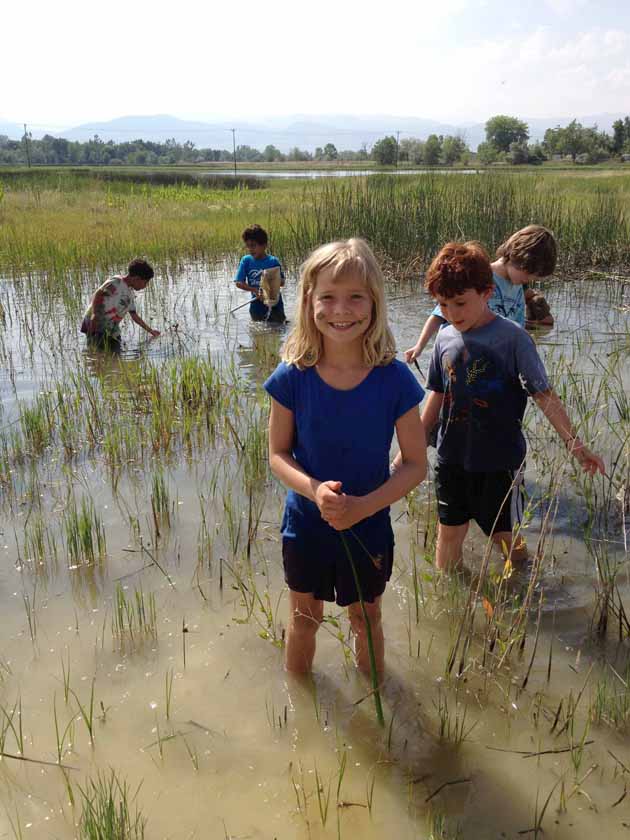
The divine art of sculpting mud pies could be one of many ways children learn about the environment, and profoundly impacts their development and identity as an environmental steward for the rest of their lives.
Four years after the Boulder Valley School District set a goal to make all graduates environmentally literate, an ongoing partnership between schools and local environmental nonprofits like Thorne Nature Experience and Wild Bear Mountain Ecology Center has led to yearly attendance of 5,000 students at Thorne Nature Experience and 20,000 contact hours at Wild Bear Mountain Ecology Center. The partnership highlights a trend in education of having experts with better funding and facilities than public schools help teach environmental literacy to K-12 students. However, both environmental education nonprofits and the Boulder County School District are still looking for meaningful ways to measure environmental literacy, under classroom time and budget constraints that don’t always allow for students to be outdoors.
“Environmental education just doesn’t teach kids about the environment but leads to them being healthier and better learners, so getting kids into the outdoors has a dramatic impact on things other than just getting them into nature,” says Keith Desrosiers, Thorne Nature Experience director. “It’s not just about teaching kids about the environment for the sake of the environment. It’s a really critical and core component of what we need to be teaching our kids in order for them to develop into responsible citizens of our society.”
Desrosiers and Thorne Nature Experience balance time between a three-class program and outdoor field trips that help connect students in low-income, low-scoring and culturally diverse schools throughout the Denver and Boulder areas to nature. Desrosiers also took part in a 2011 Boulder Valley School District task force with the director of science, teachers and representatives from other environmental education organizations to help incorporate environmental literacy into existing state standards. So far, 80 percent of the task force’s proposals have been adopted into the Boulder Valley School District curriculum.
“I think it’s a great model for environmental education,” says Ghita Carroll, sustainability coordinator for the Boulder Valley School District. “We’re working with the standards, things we’re expecting all students to learn. And we have other goals within our sustainability plan to have all staff incorporating sustainability into their position. We’re going at it from both ends. We are in a community where we have an abundance of partners and organizations offering extensive programming, and we feel very fortunate that we’re in this situation.”
But for some schools, environmental education and getting students outdoors comes down to time constraints. Jill Dreves, a former Boulder Valley elementary school teacher and current executive director of Wild Bear Mountain Ecology Center, says she has been turned down to lead environmental education field trips in Nederland on several occasions.
About 5,000 BVSD students work with Thorne Nature Experience each year. | Courtesy of Thorne Nature Experience
“It’s just that classrooms are really pigeon-holed into a specific amount of time,” Dreves says. “We had a situation where we had funding and great things to offer, and we’ve had the schools say, in general, we don’t have time for a five-minute walk from the high school to do river testing. And that’s shocking to me. Like wow, the resources are here, the funding is here, the tools are here, but the opportunity? No we can’t do that because we don’t have time.”
Because not all classrooms have the time or financial means for environmental education outside the classroom, Derosiers describes an educational model that includes “not just teacher lesson plans, but someone who can teach teachers how to build environmental education into a lesson plan. To actually pay an educator to be in a school full-time, to teach teachers how to incorporate environmental education into social science standards, into English literacy and into math standards.”
One of the biggest challenges, for both school districts and nonprofit environmental education organizations, is measuring their success. Current strategies like standardized testing are often cited as one of the reasons teachers struggle to include comprehensive environmental literacy in the classroom.
“Testing and test cores are skill-based and focused, and I think that science literacy, environmental science literacy, particularly, got lost on that,” Dreves says of Wild Bear. “It used to be where they would have a more holistic perspective on learning, where if somebody was teaching a unit on insects, they would integrate everything into it — math, literacy, social studies — and it would span across the entire day. In my opinion, that’s a very thought-provoking, higher-level thinking style in terms of learning.”
For the Boulder Valley School District, measuring success for environmental literacy can be built into tests and curriculum, but for groups like Wild Bear, which don’t test its participants, it’s harder to quantify. And private funders as well as grant providers want to see results. Wild Bear and Thorn Nature Experience both look at the number of participants as well as return rates, but Dreves says her impact reaches further than that.
“We’re not just teaching a skill — it’s hard to measure identity development,” she says. “How do you measure if somebody felt a certain way, or changed their behavior?”
Respond: [email protected]














